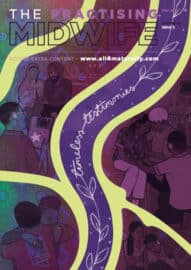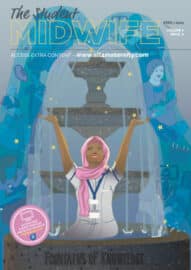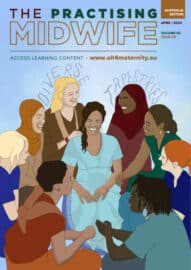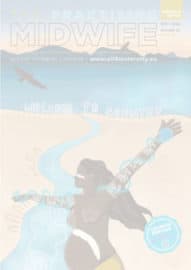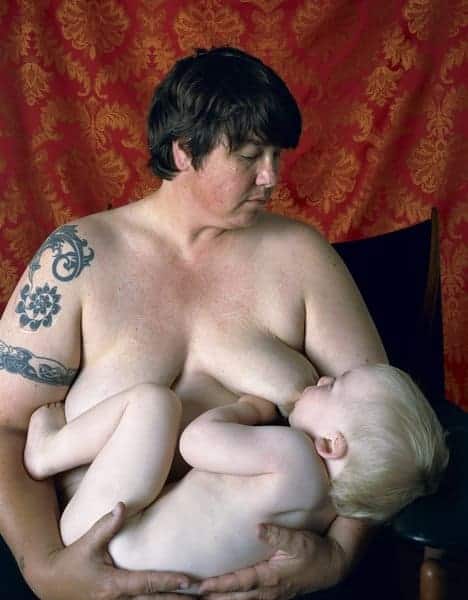What’s in a Name – Gender Inclusion in Maternity and Beyond
Laura Godfrey-Isaacs – Midwife, artist and birth activist
Recently, I debated the use of gender-based language and self-identity, both in maternity and political contexts, at the Women’s Equality Party Conference, the Association of Radical Midwives Conference and online.
Discussions have been triggered by progressive movements in identity politics that has led to an increase in visibility and inclusion of Trans and gender non-conforming people, and a subsequent look at reforming existing laws, protocols and language to reflect these socio-cultural changes. This has led to a questioning of gender-based language in maternity, by some, particularly in North America, and also a major consultation around the Gender Recognition Act GRA (2004) in the UK.
I come to this debate from a personal as well as a professional and political stance. My daughter, Tallulah is in a relationship with a Trans Man, Elijah, an actor and activist. As a result, I have become much more informed about the issues facing Trans people, particularly in healthcare, which has enhanced by understanding, as well as challenged me. I am a cis white female, from a privileged background, who has spent a lifetime as a feminist fighting for women’s rights. I also worked in the Arts for over twenty years, particularly in live art and performance, where many artists explore gender, the body and identity politics. Therefore, I thought I knew a lot about these issues, however, I now realise many of my views were entrenched and that I need to listen and learn from Trans and gender non-conforming people such as Elijah and Tallulah (Jackson, 2018).
What has been challenging is to move away from binary thinking, embrace fluid gender identities, separate sex and gender, and embrace these changes as positive for everyone, including feminists such as myself, as well as for trans, gender fluid or non-binary individuals. I now consider that these discussions are pushing the agenda and are the very place where radical gender politics is being developed, and I believe we should all embrace it.
- Elijah W Harris, Actor and Trans activist, images by Tallulah Haddon and Tiger Hutchinson-Geldorf
What is gender-neutral or inclusive language?
In the Midwives Alliance of America’s (MANA) Position Statement on Gender-Inclusive Language (2015) what is proposed is a recognition of our complex selves, a freeing, for all, from narrow binary definitions and a promotion of access to and justice for all in birth and reproductive care.
‘The same elements that threaten holistic care for pregnant and birthing folks also perpetuate violence against trans, queer and non-gender conforming people. These systems include, but are not limited to, profit-based, industrialized medical care, colonialism, sexism and patriarchy. When gender-nonconforming folks are also people of color, low-income or disabled folks, they disproportionately experience discrimination. As a result, we are committed to promoting the additive use of gender-neutral language in traditionally woman-centric movements (birth and reproductive justice) because doing so disrupts those systems and supports gender liberation.’
I think this is a brilliant framing of why gender-inclusive language is important, if we are concerned about social justice, structural inequality and gender freedom, for all.
Fears that by changing language to be gender inclusive, making it easier for Trans people to gain legal recognition or access women-only spaces, somehow threatens feminists, is, I believe, unfounded.
Gender non-conforming people are frequent victims of violence and abuse and other forms of discrimination, often do not access healthcare and have high rates of mental illness, including suicide. Therefore, people in these communities should be identified as a highly vulnerable minority group that need acceptance, support and protection, not hostility, as well as people who potentially are pushing forward on gender equality for all.

Tallulah Haddon Portrait – Paper Magazine, 2018 http://www.papermag.com/tallulah-kiss-me-first-netflix-2546460286.html
Raising awareness
Gender fluid and Trans issues are much more widely discussed and visible now. We can learn and connect with people through blogs, websites and organisations, as well as talking to people in your personal and professional life (see articles by both Tallulah in Paper Magazine and Elijah in Dazed, below).
More than ever young people self-define as gender fluid, evidenced by a recent article in the Guardian (Marsh, 2016). This means they may not identify as being either male or female, but non-binary or as either at different times. In addition, people may be Trans, so their sex at birth and their chosen gender are different, but they may need to access healthcare associated with their sex.
It is our professional responsibility, as healthcare professionals, to inform ourselves and act respectfully towards people who have these identities, and ensure they have access to healthcare without discrimination or abuse.
Here are some recommendations for books, films and articles to reference:
- ‘A Deal with the Universe’, 2018 – a film by Jason Barker, about his Trans pregnancy – interview below – ‘The film is all about coming to terms with your body,’ says Barker. ‘I’m really interested in that and how we can find peace with ourselves. I think with trans people that can be particularly poignant but I think it’s also universal. It’s what we’re all dealing with in life.’ https://film.list.co.uk/article/104985-jason-barker-on-a-deal-with-the-universe-i-was-documenting-with-a-film-in-mind/
- ‘When Boys need to go for a smear test’ by Elijah W Harris E (2018) – an account of the difficulties and issues of accessing healthcare determined by sex, for example, for a smear test, as a Trans Man. http://www.dazeddigital.com/beauty/body/article/41865/1/cervical-smear-test-as-a-trans-man
- ‘Tallulah Haddon talks New Netflix Series, Gender and Drag’ Jackson, 2018 Tallulah discusses queer identities http://www.papermag.com/tallulah-kiss-me-first-netflix-2546460286.html
- ‘Pregnant Butch’ graphic novel by A.K Summers – funny and informative account of pregnancy by a butch lesbian woman https://softskull.com/dd-product/pregnant-butch/
- Where’s the Mother?: Stories from a Transgender Dad, Trevor McDonald (2016) Trans Canada Press. Article in the Guardian: https://www.theguardian.com/society/2016/jun/20/transgender-dad-breastfeeding-pregnancy-trevor-macdonald
- ‘The Argonauts’ by Maggie Nelson (2016) Melville House UK – a memoir, ‘autotheory’ and ‘intimate portrayal of the complexities and joys of (queer) family making.’ https://www.theguardian.com/books/2015/apr/23/the-argonauts-maggie-nelson-review-harry-dodge-transgender
How can gender-inclusive terms be used in Maternity?
One of the fundamental issues to understand is the difference between sex and gender. Useful definitions, from the Lancet article ‘Transgender People: Health at the Margins’ (2016) are below:
Gender identity is described as: The personal experience of oneself as a boy or man, girl or woman, as a mix of the two, as neither, or a gender beyond man or woman…
Sex is described as: A person’s biological status (chromosomal, hormonal, gonadal, genital) as male or female (or intersex – my addition). An individual’s sex at birth (birth assigned sex) is usually determined on the basis of genital appearance….
Gender-neutral terms such as ‘people who birth’, ‘birthing folks’ or ‘birthing bodies’, can be added when writing to or addressing people. as opposed to the use of women only. Other terms such as ‘chest-feeding’ rather than breastfeeding, which is preferred by trans men, could be added and used when addressing an individual or group. A simple use of woman* (star) can also indicate that the term includes anyone that identifies as a woman.
A recent blog by midwifeshawn (2017) explored the idea of ‘mothering’ being a gender-neutral term – which for all contexts, opens up a debate about why mothering per se should be seen as gender specific, but more a term that values a certain type of caring? Here we can think about all the different types of ‘mothering’ already identified: biological, social, genetic, familial – brought forward as much by Artificial Reproductive Technologies (ART) as gender politics.
Language in Maternity and reproductive health
We all know that language in maternity is important – from the debates around the use of terms such as ‘delivery’ rather than ‘birthing’ to the dehumanising use of medical conditions to define an individual, such as ‘The CS in Room 5’ or using ‘dad’ when speaking to a partner, rather than a person’s first name.
How we have learned the impact of these, seemingly simple shifts, is by listening to feedback from service users – and here again I feel we need to listen to gender non-conforming people and trans people, and adapt our language.
Midwifery and reproductive practice – what to expect
Increasingly our identities, families and social structures are complex, which requires sophisticated and sensitive awareness by Health Care Professionals (HCP’s) – sometimes called ‘cultural competence’, and this should include an understanding of gender and sex.
In my short midwifery career, I have looked after a number of lesbian couples, and male gay couples using a surrogate. I have met families with many different identities; ethnic, cultural, socio-economic, able and disabled-bodied.
In the midwifery profession itself, this diversity is reflected, for example we have male midwives (Merz, 2014), Trans midwives (Graham, 2019) other LGBT+ midwives and an ethnically diverse workforce.
I hope that all birth workers will recognise these important socio-cultural shifts and welcome all LGBT+ people within the profession and as our clients, and enable a process of change around language and behaviour.
Recommendation for practice
Language tips
- Birth – try using ‘women and pregnant people’ or ‘Birthing bodies’
- Breastfeeding – conversations that cover ‘breastfeeding and chest-feeding’
- Personal pronouns – ask the individual if they want to use ‘he’, ‘she’ or ‘they’
- Glossary of terms – Stonewall have a useful glossary list here: https://www.stonewall.org.uk/help-advice/glossary-terms
Further reading/Information
- GIRES – Gender Identity Research & Education Society https://www.gires.org.uk
- Stonewall – leading UK LGBT charity https://www.stonewall.org.uk
- Transmedia – support with how to represent trans people in the media http://www.transmediawatch.org
- MANA – Elephant Circle –Position Statement on Gender Inclusive Language (2015) https://mana.org/healthcare-policy/position-statement-on-gender-inclusive-language
- Queer Little Family blog – https://queerlittlefamily.co.uk/about/
To hear more about LGBT+ experiences of parenting, join us at:
- Oxytocin – Mothering the World on 9thMarch at King’s College London, produced by Procreate Projects in association with the Birth Rites Collection This subject will also be discussed at a panel I’m chairing at the forthcoming event https://www.oxytocinbirthingtheworld.co.uk
References
Elephant Circle (2015) Position Statement on Gender Inclusive Language https://mana.org/healthcare-policy/position-statement-on-gender-inclusive-language
Gender Recognition Act (2004) https://www.legislation.gov.uk/ukpga/2004/7/contents
Glosswitch (2015) The Problem with talking about pregnant people https://www.newstatesman.com/politics/feminism/2015/09/what-s-matter-talking-about-pregnant-people
Goh K (2018) Jason Barker on A Deal with the Universe: ‘I was documenting with a film in mind’https://film.list.co.uk/article/104985-jason-barker-on-a-deal-with-the-universe-i-was-documenting-with-a-film-in-mind/
Graham N (2019) Meet the Trans Midwife changing ‘the worlds most gendered profession’ https://www.thestranger.com/slog/2019/01/08/37690044/meet-the-trans-midwife-changing-the-worlds-most-gendered-profession
Harris E (2018) When Boys need to go for a smear test http://www.dazeddigital.com/beauty/body/article/41865/1/cervical-smear-test-as-a-trans-man
Hinsliff G (2018) The Gender Recognition Act is Controversial https://www.theguardian.com/world/2018/may/10/the-gender-recognition-act-is-controversial-can-a-path-to-common-ground-be-found
The Lancet – Transgender People: Health at the Margins https://www.thelancet.com/pdfs/journals/lancet/PIIS0140-6736%2816%2900683-8.pdf
Marsh S (2016)The gender-fluid generation: young people on being male, female or non-binary https://www.theguardian.com/commentisfree/2016/mar/23/gender-fluid-generation-young-people-male-female-trans
Merz T (2014) No Job for a Man – Meet the Male Midwives https://www.telegraph.co.uk/men/thinking-man/11202075/No-job-for-a-man-Meet-the-male-midwives.html
MidwifeShawn (2017) Can Mothering be gender neutral? https://breechbirth.org.uk/2017/10/29/can-mothering-be-gender-neutral/
Stonewall (2018) Gender Recognition Act https://www.stonewall.org.uk/gender-recognition-act

